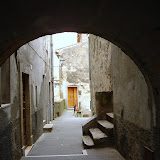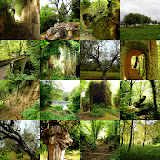
There is the "big history"and important monuments of many generations ago.
I like the modest stories documented everywhere. You just have to keep your eyes wide open and listen for example what the well worn boards of old doors to cellars in Pitigliano can tell. Not long ago they were in use and each of them closed the entrance to the Cantina where among other things wine and firewood was kept. Nowadays some are makeshift repaired, some well kept, others obviously replaced by their new owners, often strangers to the town and the old way of life. After all this will be the future...































